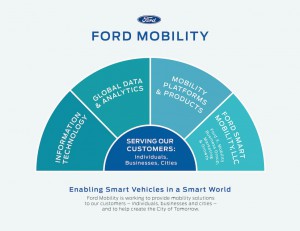Ford President and CEO Mark Hackett recently laid out the automaker’s mobility plans at CES 2018 and the company today elaborated on the structure it is putting in place to make those a reality.
“We believe transportation done right – as part of a systems approach – can bring life back to our cities,” said Marcy Klevorn, president, Ford Mobility.
“By accelerating our delivery of mobility services through the changes we are making today, we are enabling that revival, enhancing our competitiveness and creating long-term value for Ford shareholders.”
The goal is to ease the burden that traffic places on cities through the use of technology to make everything more efficient. The early efforts will begin in urban areas because they have the greatest need, Klevorn said, but that will expand as time moves on.
(Ford CEO Hackett pushes automaker’s vision of the future at CES. Click Herefor the story.)
The company plans to accelerate and launch businesses in the following areas:
Transportation operating system: The company’s Transportation Mobility Cloud that manages information flow and basic transactions between a variety of components in the transportation ecosystem – will be expanded beyond Ford to include other automakers, suppliers, partners and cities; a developer network to build and support the system also will be launched.
Connectivity: Preparing to deliver digital services to personal, fleet and city customers, Ford’s mobility team will deliver on the company’s commitment of 100 percent connectivity of new vehicles in the United States by 2019 and push toward its goal of 90 percent connectivity globally by 2020.
Ride sharing: Chariot will see an acceleration of city launches globally this year; launches will be based on a major shift in focus to the unit’s enterprise business, which provides employee transportation services for businesses.
Non-emergency medical transportation: Ford Mobility will expand its non-emergency medical transportation operation from a Southeast Michigan pilot with Beaumont Health into a full business serving multiple medical systems.
Vehicle Management as a Service: Ford Commercial Solutions is leveraging vehicle connectivity to deliver data services and fleet optimization to the commercial segment and will expand its offerings globally this year.
To do meet those targets, Ford Mobility created four new business units to handle those areas: Ford X, Mobility Marketing and Growth, Mobility Business Group, and Mobility Platforms and Products, and acquired two companies.
(Click Here for more about how a strong Q4 helped Ford turn $7.6 billion profit in 2017.)
As part of its acceleration effort, Ford acquired Autonomic and TransLoc. Ford Mobility already owned a piece of the California-based Autonomic, but elected to acquire the rest of it to more quickly set up its Transportation Mobility Cloud.
Also it will be part of Ford X and headed up by Autonomic CEO Sunny Madra. In addition to the cloud it will also act as an incubator for the group to grow and develop additional concepts.
The purchase of TransLoc, a Durham, North Carolina-based provider of demand-response technology for city-owned microtransit solutions. Acquiring TransLoc allows Ford to leverage its operational expertise, network of city relationships, and proven track record of providing solutions to cities globally that can improve the rider experience with dynamic routing.
TranLoc will be folded into the new Mobility Marketing and Growth Unit, which will drive demand with consumers and commercial and city customers, and to ensure the voice of the customer is heard throughout the organization, Ford Smart Mobility LLC is establishing a global marketing and sales team. This group brings together Ford’s City Solutions team, its regional Ford Smart Mobility leads and related marketing and sales talent into one organization, Klevorn said.
The Mobility Business Group is responsible for building existing mobility businesses, such as Ford Commercial Solutions; Ford’s microtransit businesses including Chariot and the non-emergency medical transportation unit; FordPass and digital services, including those supporting autonomous vehicle businesses, in-vehicle services and personal vehicle ownership.
It will also take over the management of businesses created under Ford X, once they are ready to move from the incubator stage, she noted.
(To see more about Hackett’s insistence on ‘no dumb cars’ in the future, Click Here.)
Essentially, the company’s product solutions group, Mobility Platforms and Products leads the design and development for the technology underpinning Ford’s mobility businesses, including connectivity, FordPass platform elements, vehicle management as a service, transportation as a service, its autonomous vehicle partnership platform and foundational platforms.



Mr. Hackett now goes my Jim (or sometimes Buddy). Mr. Fields is probably happy that he’s somewhat remembered.
Surprisingly, Ford didn’t announce the increased legal staff to support Mobility.